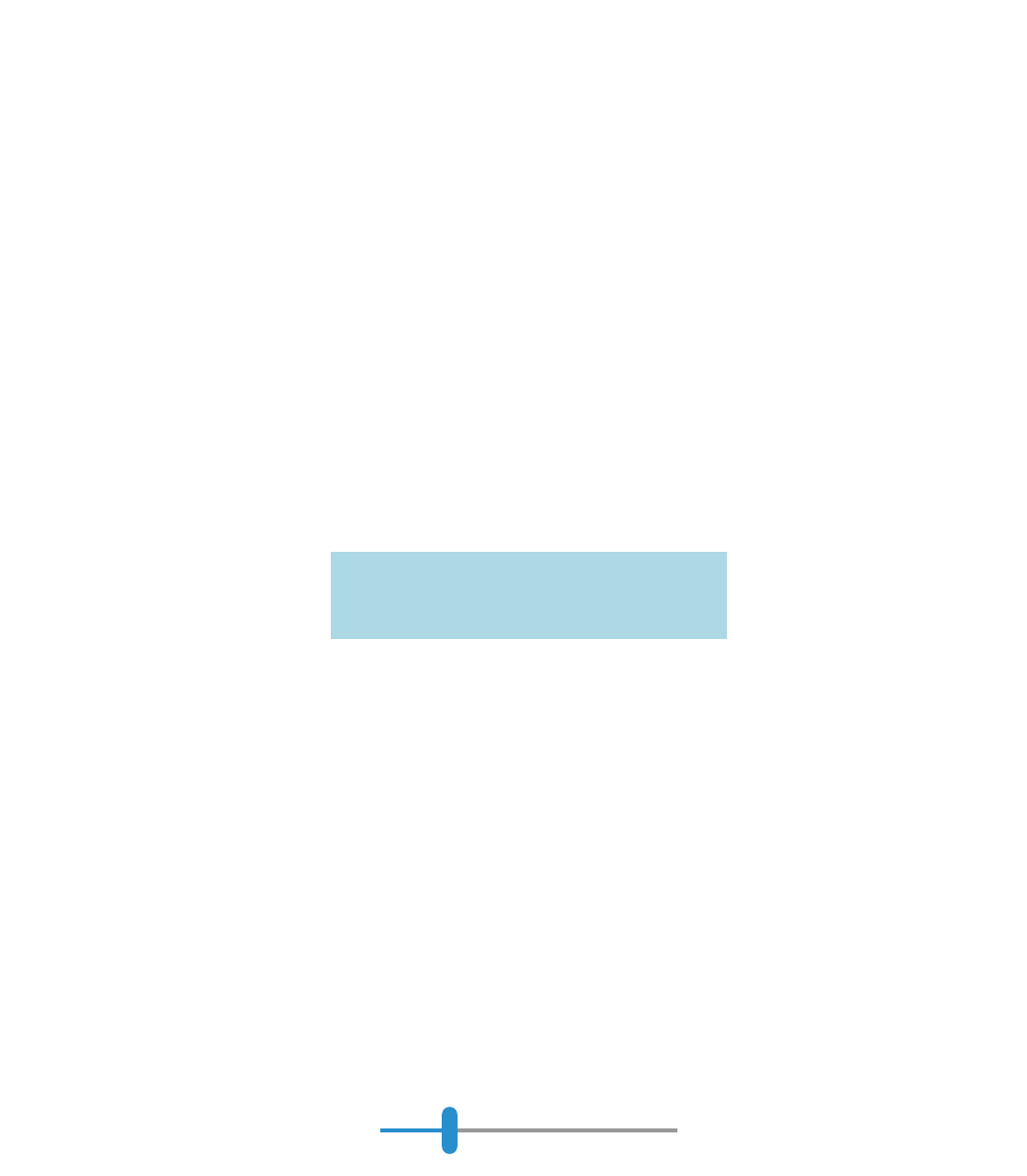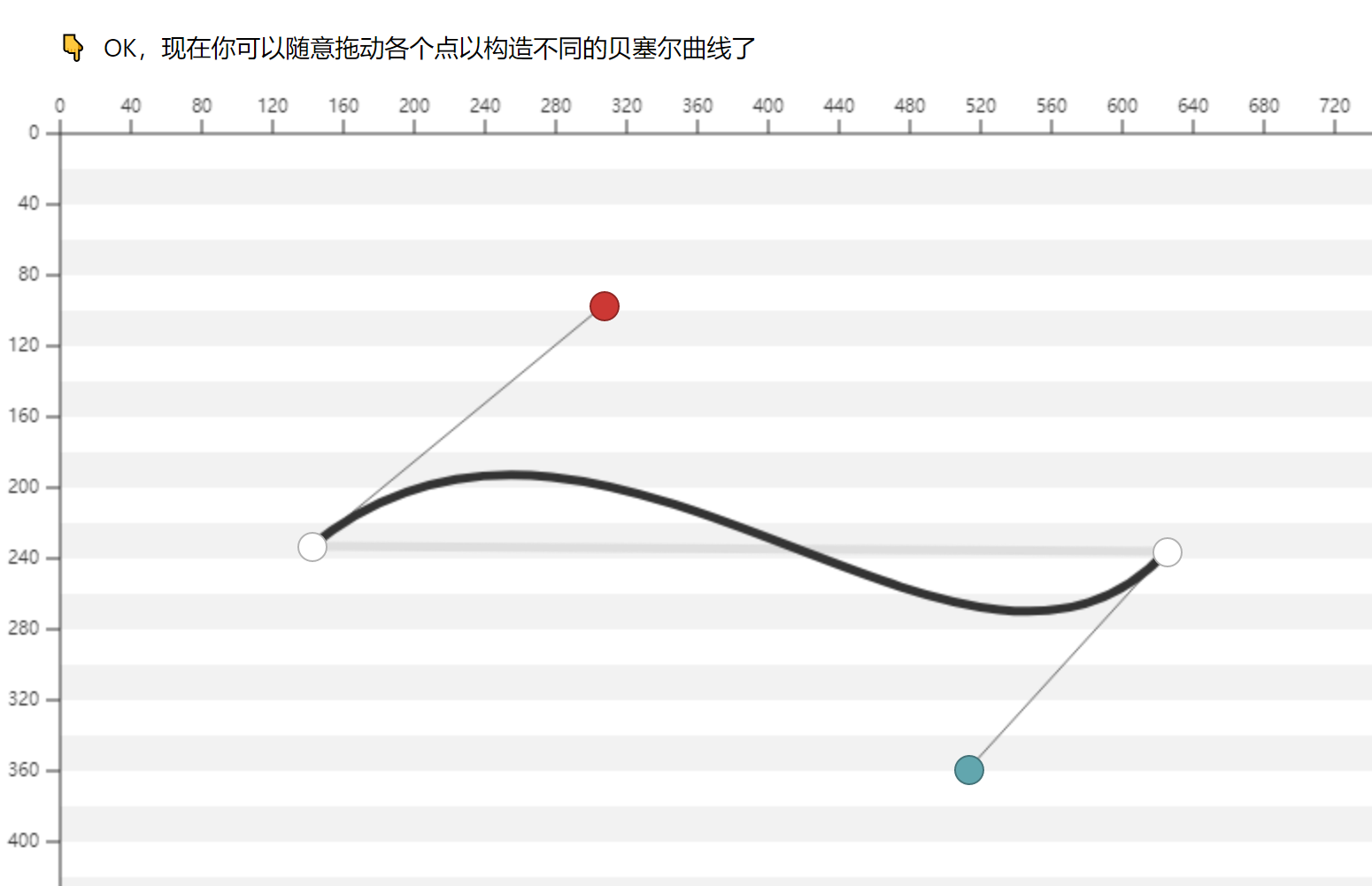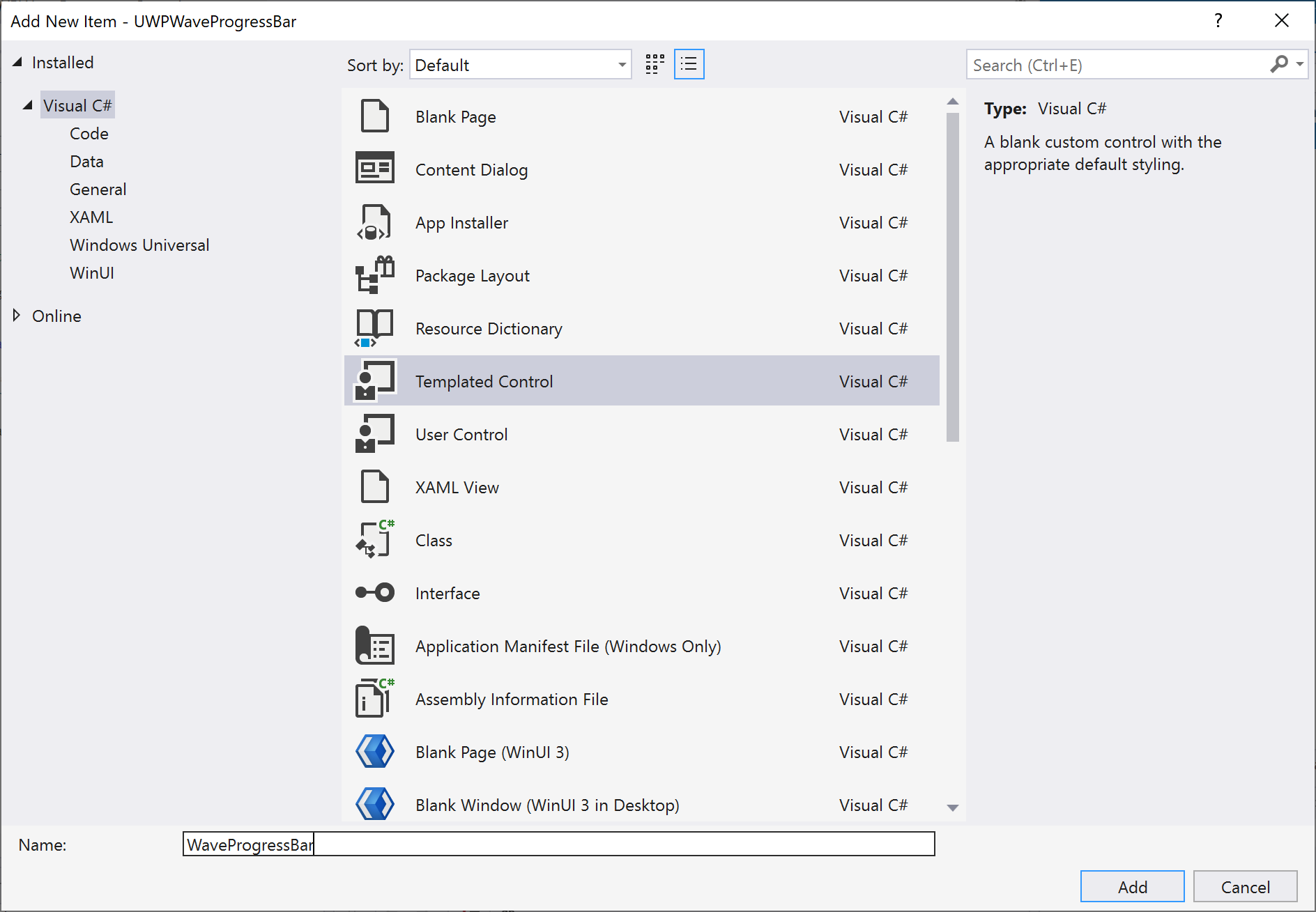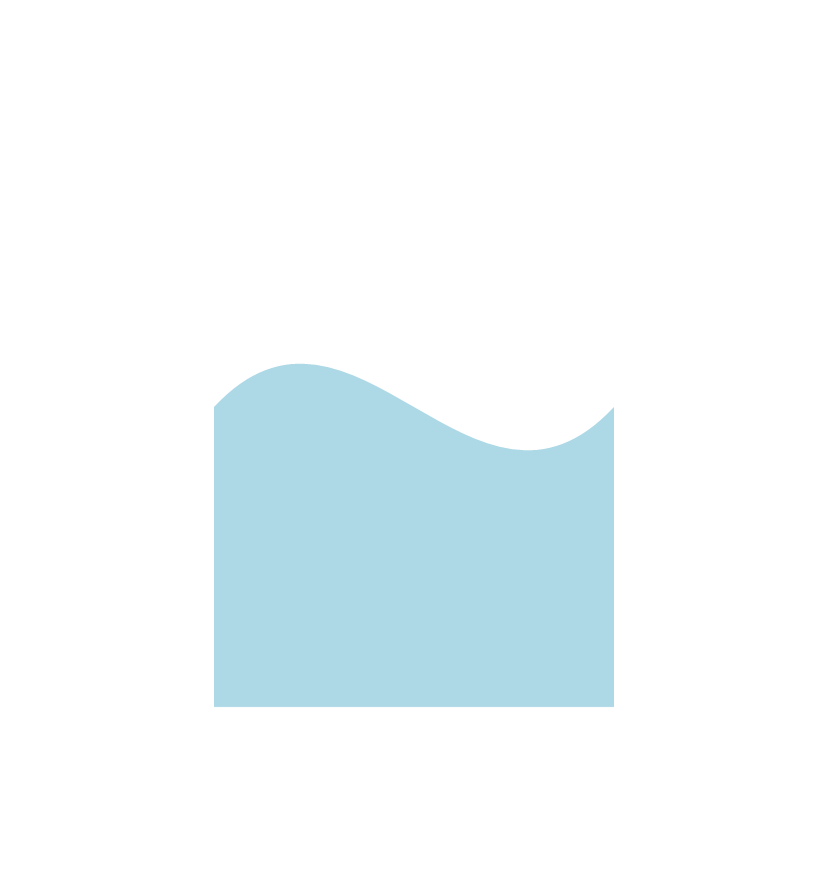- A+
好久没写 blog 了,一个是忙,另外一个是觉得没啥好写。废话不多说,直接上效果图:

可能看到这波浪线你觉得会很难,但看完这篇 blog 后应该你也会像我一样恍然大悟。图上的图形,我们可以考虑是由 3 条直线和 1 条曲线组成。直线没什么难的,难的是曲线。在曲线这一领域,我们有一种特殊的曲线,叫贝塞尔曲线。
在上面这曲线,我们可以对应到的是三次方贝塞尔曲线,它由 4 个点控制,起点、终点和两个控制点。这里我找了一个在线的 demo:https://www.bezier-curve.com/

调整控制点 1(红色)和控制点 2(蓝色)的位置我们可以得到像最开始的图那样的波浪线了。
另外,我们也可以注意到一个性质,假如起点、终点、控制点 1 和控制点 2 都在同一条直线上的话,那么我们这条贝塞尔曲线就是一条直线。

按最开始的图的动画,我们最终状态是一条直线,显然就是需要这 4 个点都在同一直线上,然而在动画过程中,我们需要的是一条曲线,也就是说动画过程中它们不会在同一直线上了。我们也可以注意到,在波浪往上涨的时候,左边部分是凸起来的,而右半部分是凹进去的。这对应了控制点 1 是在直线以上,而控制点 2 在直线以下。那么如何在动画里做到呢,很简单,使用缓动函数就行了,让控制点 1 的值更快到达最终目标值,让控制点 2 的值更慢到达最终目标值即可。(当然,单纯使用时间控制也行,在这里我还是用缓动函数)
理论已经有了,现在让我们开始编码。
新建一个 UWP 项目,然后我们创建一个模板控件,叫 WaveProgressBar。之所以不继承自 ProgressBar,是因为 ProgressBar 上有一个 IsIndeterminate 属性,代表不确定状态,我们的 WaveProgressBar 并不需要,简单起见,我们还是从模板控件开始。

接下来我们修改 Generic.xaml 中的控件模板代码
<Style TargetType="local:WaveProgressBar"> <Setter Property="Background" Value="LightBlue" /> <Setter Property="Template"> <Setter.Value> <ControlTemplate TargetType="local:WaveProgressBar"> <Viewbox Stretch="Fill"> <Path Width="100" Height="100" Fill="{TemplateBinding Background}"> <Path.Data> <PathGeometry> <PathGeometry.Figures> <PathFigure StartPoint="0,100"> <PathFigure.Segments> <LineSegment x:Name="PART_LineSegment" Point="0,50" /> <BezierSegment x:Name="PART_BezierSegment" Point1="35,25" Point2="65,75" Point3="100,50" /> <LineSegment Point="100,100" /> </PathFigure.Segments> </PathFigure> </PathGeometry.Figures> </PathGeometry> </Path.Data> </Path> </Viewbox> </ControlTemplate> </Setter.Value> </Setter> </Style>
这里我使用了一个 Viewbox 以适应 Path 缩放。Path 大小我们定义为 100x100,然后先从左下角 0,100 开始绘制,绘制一条直线到 0,50,接下来绘制我们的贝塞尔曲线,Point3 是终点 100,50,最后我们绘制了一条直线从 100,50 到 100,100。另外因为 PathFigure 默认就是会自动封闭的,所以我们不需要画 100,100 到 0,100 的这一条直线。当然以上这些点的坐标都会在运行期间发生变化是了,这里这些坐标仅仅只是先看看效果。
加入如下代码到我们的页面:
<local:WaveProgressBar Width="200" Height="300" />
运行程序应该会看到如下效果:

接下来我们就可以考虑我们的进度 Progress 属性了,这里我定义 0 代表 0%,1 代表 100%,那 0.5 就是 50% 了。定义如下依赖属性:
public class WaveProgressBar : Control { public static readonly DependencyProperty ProgressProperty = DependencyProperty.Register( nameof(Progress), typeof(double), typeof(WaveProgressBar), new PropertyMetadata(0d, OnProgressChanged)); public WaveProgressBar() { DefaultStyleKey = typeof(WaveProgressBar); } public double Progress { get => (double)GetValue(ProgressProperty); set => SetValue(ProgressProperty, value); } private static void OnProgressChanged(DependencyObject d, DependencyPropertyChangedEventArgs e) { throw new NotImplementedException(); } }
由于我们要对 Path 里面的点进行动画,所以先在 OnApplyTemplate 方法中把它们拿出来。
[TemplatePart(Name = LineSegmentTemplateName, Type = typeof(LineSegment))] [TemplatePart(Name = BezierSegmentTemplateName, Type = typeof(BezierSegment))] public class WaveProgressBar : Control { public static readonly DependencyProperty ProgressProperty = DependencyProperty.Register( nameof(Progress), typeof(double), typeof(WaveProgressBar), new PropertyMetadata(0d, OnProgressChanged)); private const string BezierSegmentTemplateName = "PART_BezierSegment"; private const string LineSegmentTemplateName = "PART_LineSegment"; private BezierSegment _bezierSegment; private LineSegment _lineSegment; public WaveProgressBar() { DefaultStyleKey = typeof(WaveProgressBar); } public double Progress { get => (double)GetValue(ProgressProperty); set => SetValue(ProgressProperty, value); } protected override void OnApplyTemplate() { _lineSegment = (LineSegment)GetTemplateChild(LineSegmentTemplateName); _bezierSegment = (BezierSegment)GetTemplateChild(BezierSegmentTemplateName); } private static void OnProgressChanged(DependencyObject d, DependencyPropertyChangedEventArgs e) { throw new NotImplementedException(); } }
接着我们可以考虑动画部分了,这里应该有两个地方会调用到动画,一个是 OnProgressChanged,Progress 值变动需要触发动画。另一个地方是 OnApplyTemplate,因为控件第一次出现时需要将 Progress 的值立刻同步上去(不然 Progress 跟看上去的不一样),所以这个是瞬时的动画。
配合最开始的理论,我们大致可以编写出如下的动画代码:
private void PlayAnimation(bool isInit) { if (_lineSegment == null || _bezierSegment == null) { return; } var targetY = 100 * (1 - Progress); var duration = new Duration(TimeSpan.FromSeconds(isInit ? 0 : 0.7)); var storyboard = new Storyboard(); var point1Animation = new PointAnimation { EnableDependentAnimation = true, Duration = duration, To = new Point(0, targetY), EasingFunction = new BackEase { Amplitude = 0.5 } }; Storyboard.SetTarget(point1Animation, _lineSegment); Storyboard.SetTargetProperty(point1Animation, nameof(_lineSegment.Point)); storyboard.Children.Add(point1Animation); var point2Animation = new PointAnimation { EnableDependentAnimation = true, Duration = duration, To = new Point(35, targetY), EasingFunction = new BackEase { Amplitude = 1.5 } }; Storyboard.SetTarget(point2Animation, _bezierSegment); Storyboard.SetTargetProperty(point2Animation, nameof(_bezierSegment.Point1)); storyboard.Children.Add(point2Animation); var point3Animation = new PointAnimation { EnableDependentAnimation = true, Duration = duration, To = new Point(65, targetY), EasingFunction = new BackEase { Amplitude = 0.1 } }; Storyboard.SetTarget(point3Animation, _bezierSegment); Storyboard.SetTargetProperty(point3Animation, nameof(_bezierSegment.Point2)); storyboard.Children.Add(point3Animation); var point4Animation = new PointAnimation { EnableDependentAnimation = true, Duration = duration, To = new Point(100, targetY), EasingFunction = new BackEase { Amplitude = 0.5 } }; Storyboard.SetTarget(point4Animation, _bezierSegment); Storyboard.SetTargetProperty(point4Animation, nameof(_bezierSegment.Point3)); storyboard.Children.Add(point4Animation); storyboard.Begin(); }
对于 OnApplyTemplate 的瞬时动画,我们直接设置 Duration 为 0。
接下来 4 个点的控制,我们通过使用 BackEase 缓动函数,配上不同的强度(Amplitude)来实现控制点 1 先到达目标,然后是起点和终点同时到达目标,最后控制点 2 到达目标。
最后 WaveProgressBar 的完整代码应该是这样的:
[TemplatePart(Name = LineSegmentTemplateName, Type = typeof(LineSegment))] [TemplatePart(Name = BezierSegmentTemplateName, Type = typeof(BezierSegment))] public class WaveProgressBar : Control { public static readonly DependencyProperty ProgressProperty = DependencyProperty.Register( nameof(Progress), typeof(double), typeof(WaveProgressBar), new PropertyMetadata(0d, OnProgressChanged)); private const string BezierSegmentTemplateName = "PART_BezierSegment"; private const string LineSegmentTemplateName = "PART_LineSegment"; private BezierSegment _bezierSegment; private LineSegment _lineSegment; public WaveProgressBar() { DefaultStyleKey = typeof(WaveProgressBar); } public double Progress { get => (double)GetValue(ProgressProperty); set => SetValue(ProgressProperty, value); } protected override void OnApplyTemplate() { _lineSegment = (LineSegment)GetTemplateChild(LineSegmentTemplateName); _bezierSegment = (BezierSegment)GetTemplateChild(BezierSegmentTemplateName); PlayAnimation(true); } private static void OnProgressChanged(DependencyObject d, DependencyPropertyChangedEventArgs e) { var obj = (WaveProgressBar)d; obj.PlayAnimation(false); } private void PlayAnimation(bool isInit) { if (_lineSegment == null || _bezierSegment == null) { return; } var targetY = 100 * (1 - Progress); var duration = new Duration(TimeSpan.FromSeconds(isInit ? 0 : 0.7)); var storyboard = new Storyboard(); var point1Animation = new PointAnimation { EnableDependentAnimation = true, Duration = duration, To = new Point(0, targetY), EasingFunction = new BackEase { Amplitude = 0.5 } }; Storyboard.SetTarget(point1Animation, _lineSegment); Storyboard.SetTargetProperty(point1Animation, nameof(_lineSegment.Point)); storyboard.Children.Add(point1Animation); var point2Animation = new PointAnimation { EnableDependentAnimation = true, Duration = duration, To = new Point(35, targetY), EasingFunction = new BackEase { Amplitude = 1.5 } }; Storyboard.SetTarget(point2Animation, _bezierSegment); Storyboard.SetTargetProperty(point2Animation, nameof(_bezierSegment.Point1)); storyboard.Children.Add(point2Animation); var point3Animation = new PointAnimation { EnableDependentAnimation = true, Duration = duration, To = new Point(65, targetY), EasingFunction = new BackEase { Amplitude = 0.1 } }; Storyboard.SetTarget(point3Animation, _bezierSegment); Storyboard.SetTargetProperty(point3Animation, nameof(_bezierSegment.Point2)); storyboard.Children.Add(point3Animation); var point4Animation = new PointAnimation { EnableDependentAnimation = true, Duration = duration, To = new Point(100, targetY), EasingFunction = new BackEase { Amplitude = 0.5 } }; Storyboard.SetTarget(point4Animation, _bezierSegment); Storyboard.SetTargetProperty(point4Animation, nameof(_bezierSegment.Point3)); storyboard.Children.Add(point4Animation); storyboard.Begin(); } }
修改项目主页面如下:
<Grid> <local:WaveProgressBar Width="200" Height="300" Progress="{Binding ElementName=Slider, Path=Value}" /> <Slider x:Name="Slider" Width="200" Margin="0,0,0,20" HorizontalAlignment="Center" VerticalAlignment="Bottom" Maximum="1" Minimum="0" StepFrequency="0.01" /> </Grid>
此时再运行的话,你就会看到如本文开头中动图的效果了。
本文的代码也可以在这里找到:https://github.com/h82258652/UWPWaveProgressBar




